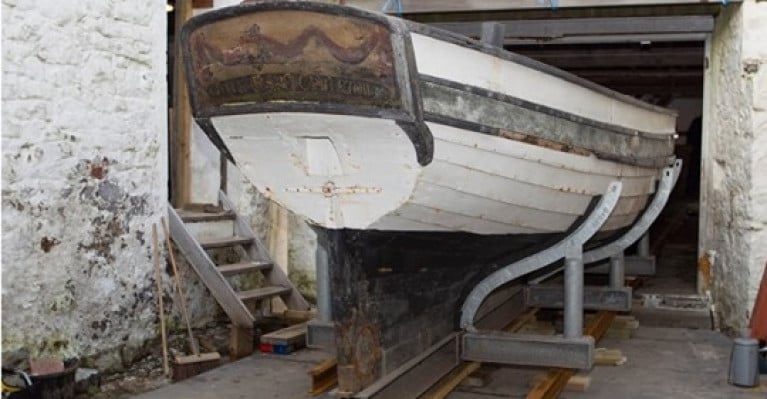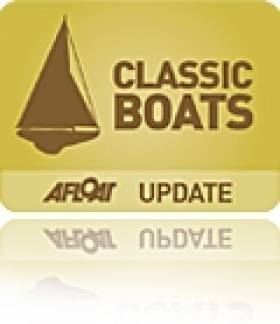Displaying items by tag: Peggy
In the Isle of Man, a historic boat is to return to the Nautical Museum.
Moving an 18th century schooner back to the Nautical Museum in Castletown is expected to cost more than £5 million.
The Peggy was removed for conservation work in 2015 after being housed in what were described as 'appalling conditions'.
A motion is going before the Manx Government (yesterday, 18 May) to set out a timeline for the boat's return.
Manx National Heritage Chairman Jonathan Hall spoke to Local Democracy Reporter Chris Cave, to listen, Manx Radio reports.
Read WM Nixon's full blog on Peggy here
New Lease of Life for Vintage Wooden Boats Is a Maritime Highlight
#woodenboats – It's an interesting time for old wooden boats. They may be traditional craft, or classics, or simply ordinary timber boats which have reached a stage in life where they need serious and special attention. Whatever the circumstances, it's clear that their situation strikes a chord with sailors everywhere. And when there's good news about a restoration, it heartens the maritime community to know that worthwhile plans are being implemented. W M Nixon takes us on a tour.
The maritime highlight of this past week was down in the far southwest, at the ceremony in Liam Hegarty's boatyard at Oldcourt above Baltimore on the River Ilen when the "whiskey plank" was fastened in place to complete the hull re-build of the 1926 Conor O'Brien 56ft trading ketch Ilen. It has been a long haul since Ilen was brought back to Ireland from her working area in the Falkland Islands in 1997. Yet somehow, despite all sorts of problems of which the economic recession was only one, the Ilen really is starting to look ship-shape again.
Then in another part of the country, the word had come through that one of the Belfast Lough 27ft S Class sloops, twenty of which were built on the shores of Ballyholme Bay between 1946 and 1963, was facing extinction in a corner of County Louth. The news resulted in a flurry of photos on the Afloat.ie website spurred on by the indefatigable Pat Murphy, and soon the Sorona found herself a new home in a yard in Newry.
There, the story is that she'll be sharing space with the vintage ketch Silvery Light, a substantial vessel built in 1884 on the beach at St Ives in Cornwall to be a herring drifter, and now undergoing a much-needed restoration in Newry after being brought by new owners into Carlingford Lough last Autumn.
Sorona may have been only 52 years old. But her deteriorating condition was a reminder that the climate of Ireland and the seas around us can be merciless to a wooden vessel unless - whether deliberately or by happy accident - the boat is stored in a timber-friendly sheltered environment which is not too hot or cold, nor excessively wet or dry.
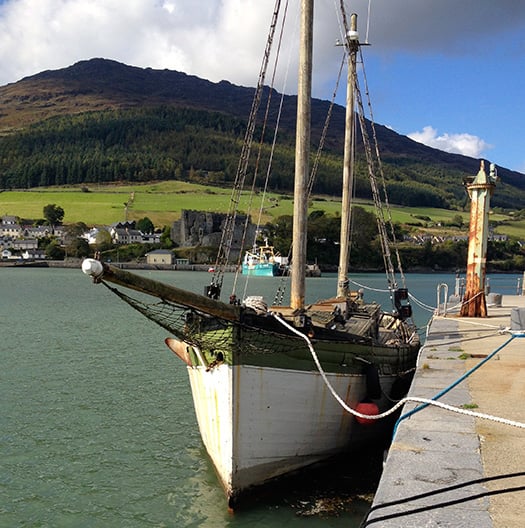 A formidable restoration challenge. The 1884-built ketch Silvery Light – seen here in Carlingford last October – will be undergoing restoration in Newry. Photo: Peter Redmond
A formidable restoration challenge. The 1884-built ketch Silvery Light – seen here in Carlingford last October – will be undergoing restoration in Newry. Photo: Peter Redmond
In the middle of the Irish Sea in the ancient capital of the Isle of Man at Castletown, the 26ft schooner Peggy had survived remarkably well in her harbourside "boat cellar" under Bridge House. In fact, her survival was miraculous, as Peggy was built in 1789, making her probably the oldest yacht in the world. But in recent years, it became clear that a major conservation project was going to be needed to preserve this unique craft.
And just three weeks ago, for the first time in 180 years, the Peggy was removed from her private space in a skilled operation. She is now safely ensconced in a specially prepared conservation workshop in the island's modern capital of Douglas, where it is anticipated the painstaking process of preserving this exceptional gem of maritime heritage could take five years.
Once you have the ideal conditions of micro-climate in place for doing the job, conservation is a long haul, a project of infinite patience. One of the best examples of how it can be done successfully is in Dublin with the Asgard, now on display in Collins Barracks. John Kearon, who learned his shipwright skills in Arklow and then broadened them to include historical work with the Liverpool Maritime Museum, was to lead the team working on this from 2007 until its completion in 2012.
The result is a multi-value display, as the 1905-built Asgard has her place in Irish history through the 1914 gun-running to Howth, she is also totally associated with Erskine Childers which takes us, among other elements in a complex history, into the world of his 1903 best-selling espionage novel The Riddle of the Sands, and she is a marvellous example of the work of the great designer-builder Colin Archer of Norway in creating a very able seagoing yacht of the era, one of the best cruising vessels of her time.
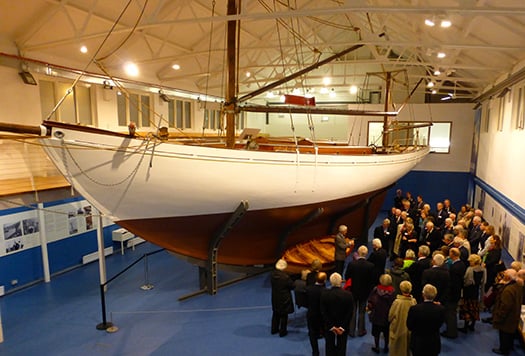
The Asgard in Collins Barracks is a fine example of conservation. A group of Erskine Childers enthusiasts from the Royal Cruising Club is seen here listening intently to a talk by conservator John Kearon about the vessel and the preservation work done with her by his team. Throughout her ownership by Erskine & Molly Childers from 1905, Asgard played a prominent role in the activities of the RCC, and in 1913 their friend Gordon Shepherd was awarded the club's historic Challenge Cup for his remarkable Autumn cruise with Asgard from Norway to North Wales via the Shetland Islands and the Hebrides. Photo: W M Nixon
In her day, the little Peggy was also something of a unique star. Though based in the Isle of Man and most active during the 1890s, she was never in Ireland. Had she been seen on the Irish coast, it would probably have been because she'd been captured by the privateers and smugglers of Rush in North Dublin, who were the capture and contraband industry leaders of their day.
So when Peggy's owner George Quayle (1751-1835) took her "abroad", it was prudently to northern England to race successfully against a small fleet of early yachts on Windermere in the Lake District, though we can be sure that if the men of Rush had come anywhere near him, Quayle would have put up a gallant fight, as Peggy was an armed yacht with miniature cannons which most certainly weren't toys.
But it's the realization that Quayle was active at sea with the Peggy in the years after Luke Ryan of Rush was at his busiest, yet before James Mathews of the same port was at his most active, which helps us to grasp her historical significance. She was sailing the Irish Sea well before the Battle of Trafalgar. But thanks to being immured for a hundred years in her boat cellar after George Quayle died in 1835, this small but significant vessel has survived to become something of extraordinary value today.
Her inevitable deterioration was accelerating in recent years because of mineralization of her fastenings, which were not only consuming themselves, but were damaging all the timber about them. However, her conservation was not something to be undertaken lightly. The provision of a proper facility had to be organised, and then the liftout, clear over the tops of the harbourside houses, had to be planned within inches.
It was all relatively new territory for many of those involved, with much preparatory work. So what had originally been planned as an Autumn 2014 lift finally became possible in late January 2015, just when the weather went to pot, with one gale after another making for impossible conditions. But then one cold Thursday morning at the end of January, the wind maps suggested the arrival of a brief lull in the northwest gales. It arrived exactly on time on a sunny day suggestive of early Spring, and gently but steadily the Peggy emerged.
As Chris Weeks of Manx Heritage remarked as he watched from the parapet above George Quayle's little boat dock, the one thing
they didn't want to hear was any creaking or groaning. If the special lifting cradle was doing its job, the Peggy would rise from her nest of 180 years in perfect silence. And that's exactly how it went, with the lift done in two stages as they were working in very confined streets and spaces.
{youtube}-UyKjwdAhgw{/youtube}
Of course, after all the fuss those of us in the Peggy Appreciation Society have been making for years, when she did finally come into the open the inevitable reaction was: "But she's very small". What on earth did they expect? Something like Nelson's Victory rising up over the old houses of Castletown? How many times do we have to reiterate that she's only 26ft in overall length, just a foot longer overall than a Folkboat, though with greater bulk and a longer waterline.
What her emergence did properly reveal, for the first time in all those 180 years, is just how much the Peggy is a vessel of her era. This is indeed a ship – albeit a miniature one – of the 18th Century. But she's an 18th Century high performance mini-ship nevertheless – this is undoubtedly a vessel well worth conserving.
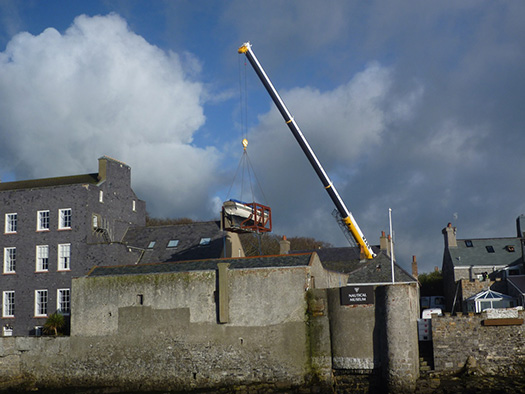
Peggy aloft. The newest crane in the Isle of Man lifts the oldest boat in the Isle of Man. Photo: Michael Kneale
So the day went well. And for those with a technical interest in such things, the word is that the delicate lifting of the oldest boat in the Isle of Man was done by the newest crane on the Isle of Man, a Japanese made Tadano recently delivered (for a cool £550,000) to Mann Crane Hire whose boss Chris Barnes was understandably proud of the smooth work put in by his supervisor Colin Fitzgerald and crane driver David Hooper.
Thanks to their good work everyone was able, for the first time in 180 years, to fully admire and savour the Peggy's lines. To the uninitiated, she may look like just another 26ft clinker-built boat. But for connoisseurs, she's living history with a stylish hull, as she has the most gorgeous hollow waterlines forward, and a sweet run aft – George Quayle had himself a flyer.
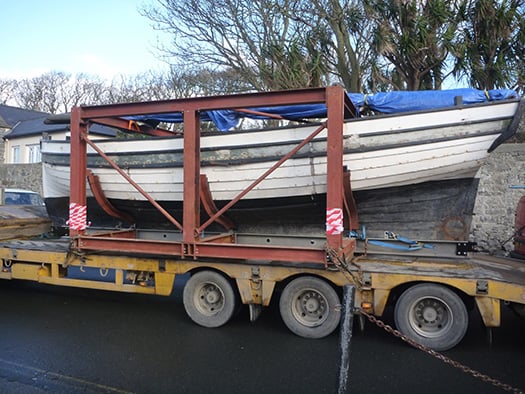 To a casual observer, this may look like just another 26ft clinker-built boat. But for connoisseurs, this is a genuine miniature of a 17th Century ship - the Peggy is very special. Photo: Michael Kneale
To a casual observer, this may look like just another 26ft clinker-built boat. But for connoisseurs, this is a genuine miniature of a 17th Century ship - the Peggy is very special. Photo: Michael Kneale
So it's a bit sad that, as with the Asgard, we have to accept that conservation means the Peggy will never sail again. But thanks to John Kearon's painstaking work, the plans of Asgard as she was originally in 1905 are readily available for any group wishing to build a seagoing replica. Stranger things have happened. And as the Peggy is of such a manageable size, it's even more likely that a new seagoing replica of the little Manx schooner will appear some time, and maybe sooner rather than later. After all, she'd be much the same size as the "new" Shannon hooker Sally O'Keeffe down in Kilrush, which is absolutely on target as a community maritime project.
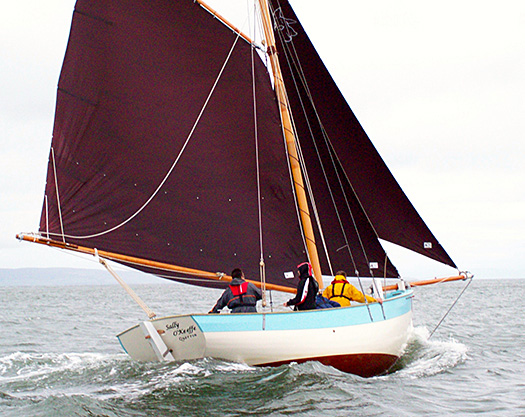
The 2012-built Sally O'Keeffe on the Shannon Estuary is much the same size as the Peggy of Castletown.
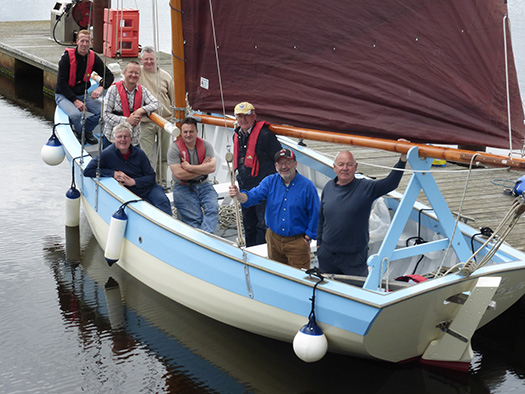 A genuine community project. Some of the team who built Sally O'Keeffe in Querrin aboard the boat in Kilrush with lead builder Steve Morris second left in the trio up forward. Photo: W M Nixon
A genuine community project. Some of the team who built Sally O'Keeffe in Querrin aboard the boat in Kilrush with lead builder Steve Morris second left in the trio up forward. Photo: W M Nixon
Nevertheless after immersing ourselves in the dusty academic topic of proper boat conservation, it's like a breath of fresh air to consider the Ilen, for she will definitely sail again. Tom MacSweeney of this parish was at the ceremony, so we'll defer to himself for his detailed report on the occasion in the fullness of time. But just from looking at the photos, you can get some idea of the quality of the workmanship that Gary MacMahon and his team from the Ilen Trust and Boatbuilding School in Limerick are getting from Liam Hegarty and his shipwrights at Oldcourt.
The pure style of the new planking is a joy to behold. And as for the use of classic bronze spikes for the fastenings, they're a work of the craftsman's art in themselves. Gary MacMahon brought one along to the recent Sail Training Ireland Annual Awards ceremony in the Mansion House in Dublin, and in that setting and on that occasion, you couldn't help but think that if our impoverished nation had been able to utilise bronze fastenings of this standard in Asgard II when building her in the late 1970s, rather than the galvanized steel fastenings that had to be used, then our beloved sail training brigantine might still be sailing today.
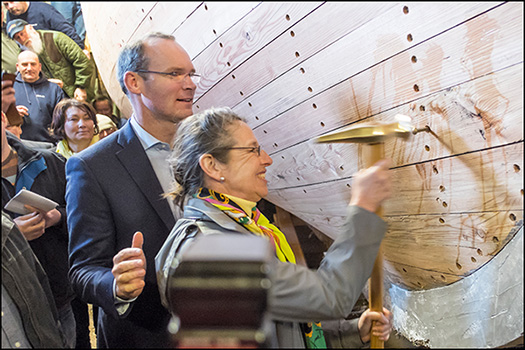
Quality work at every level. The superb workmanship on the Ilen restoration by Liam Hegarty is much in evidence as Minister for the Marine Simon Coveney supports Kate Jarvey of the Ruth Lilly Philanthropic Trust as she drives the bronze fastening to complete the "whiskey plank". Photo: Kevin O'Farrell
But Asgard II is long gone, and so too is Conor O'Brien's Saoirse, the 42ft Baltimore-built ketch in which the Limerick sailor made his extraordinary voyage round the word south of the Great Capes in 1922-25. Thus Ilen is the only tangible link to that remarkable and very historic achievement. For those who enjoy looking at line drawings of boats (not everyone does - there are some who claim that such technical stuff makes them feel "disenfranchised"), it's intriguing to compare the lines of the 42ft Saoirse and the 56ft Ilen.
They're clearly sisters, but you'll note that the Ilen people have made sure that Tom Moynihan of Baltimore is given a significant amount of credit for the design, for down in West Cork they'll tell you that for all that Conor O'Brien was an architect by profession, it took Tom Moynihan's skills to turn his rough concept sketches into vessels capable of sailing so ably across the oceans.
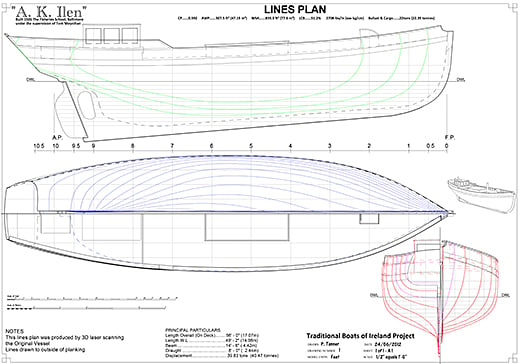
The lines of Ilen as taken off the hull by laser scanner
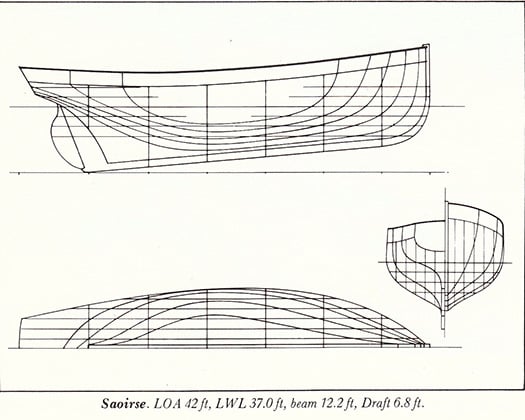
The hull lines of Saoirse as interpreted by Myles Stapleton (designer of Sally O'Keeffe) from basic drawings by Conor O'Brien
An Irish designer who didn't need anyone's help to make his creations look like proper boats was John B Kearney (1879-1967). He may have started his working life as a boy apprentice at Murphy's Boatyard in Ringsend in the early 1890s, while his working life was to be spent with Dublin Port & Docks where he rose to be Superintendent of Engineering Works. But his lifetime ambition was always to be a yacht designer, he trained and studied for it in his very limited spare time from boyhood, and then he worked at it throughout his long retirement. When he finally died at the age of 87, his gravestone in Glasnevin says it all, as it simply reads: John Breslin Kearney.....Yacht Designer. Beloved and respected by all that knew him.
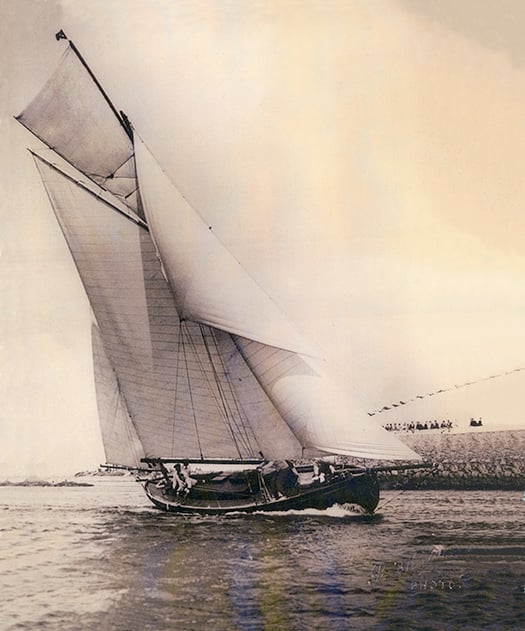
Mavis in her element under Skipper Kearney's command, on her way to winning Skerries Regatta in 1928
For everyone who sailed with him in his many successful cruises and races, he was always Skipper Kearney, and Skipper Kearney's finest creation was the 38ft yawl Mavis which he designed and built himself in Ringsend in 1923-25. Mavis went to America in 1956, and from time to time we've mentioned the continuing process of restoration on her in Camden, Maine, which has been going on for quite a few years now. It has been a lengthy process as owner/restorer Ron Hawkins has to take time out now and again to earn extra funds as a shipwright in order to to keep the Mavis restoration show on the road.
But it's getting there at last. So much so, indeed, that having given the hull of Mavis its first coat of paint in more than twenty years just a couple of weeks ago, Ron and his partner Denise Pukas are now talking of a re-launch date of July 4th 2015 for the restored ship, this treasure of the Irish yacht designer's art and craft.
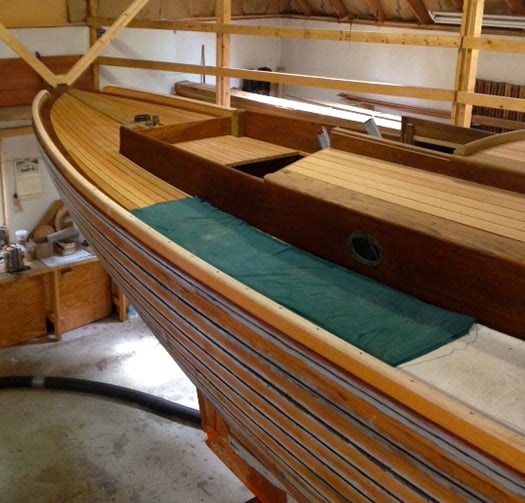
The quality of workmanship in the restoration of Mavis is clearly displayed. Note how John B Kearney skillfully carried the beam well aft in order to provide a wide and comfortable afterdeck despite incorporating a canoe stern. Photo: Denise Pukas
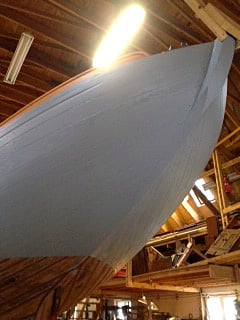
The canoe stern on Mavis with its first coat of fresh paint in 20 years. Here we can appreciate again how John Kearney managed to have an elegant canoe stern while providing plenty of deck space aft. Photo: Denise Pukas
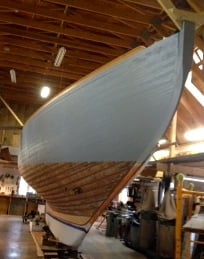
The most famous Kearney hull of all begins to emerge from restoration. It is hoped to re-launch Mavis on July 4th 2015. Photo: Denise Pukas
It would be pleasant to keep this week's commentary on a good news theme right through to the end, but the various emails about saving the Sorona from an untimely end in County Louth brought the information that there are skilled boatbuilders in places like Arklow who are looking for boats needing restoration - not as a commercial venture, but rather as a worthwhile private project.
The secret of it all is surely being able to assess if a particular boat is too far gone to be within your restoration capabilities and resources. Be that as it may, it was sadly ironic to reflect that within yards of the bright and cheerful festival which celebrated the final plank being installed on the Ilen, there's a derelict little boat which would be very rewarding to restore, but it's likely that she's so far gone it's actually a re-build you'd be contemplating.
We're talking of the Englyn, the Harrison Butler-designed 26-footer which came up on the radar last May when were discussing the new 31ft Harrison Butler-designed Khamseen class which Steve Morris, lead builder of the Sally O'Keeffe, is constructing beside his house near Kilrush. But while Steve's boat is starting to look very healthy indeed, sad little Englyn is anything but as she lies abandoned within yards of the Old Cornstore where Ilen is being so beautifully re-born.
Part of the problem in getting anyone interested in the Englyn – which was built in 1934 in Southampton – is that her only link to Ireland was through various owners later in her life. Yet in her day she was considered a classic, so much so that when Eric Hiscock's defining book Cruising Under Sail was published in 1950, Englyn was one of the featured designs. And as the designer Harrison Butler was professionally an ophthalmic surgeon who put heart and soul into everything he did, when Hiscock asked him for the plans he went to infinite pains to bring them to life as a vision of a proper little cruising yacht, even to having a trussed chicken shown in the meat locker.
Over and above that, when looking at Englyn's plans it's not unreasonable to think that, 25 years before Lyle Hess was starting to design his first characterful boats, Harrison Butler was thinking along much the same lines. And he had the boats afloat to prove it.
But that piece of thinking is another day's work. For now, give us a moment of your time to consider the drawings of Englyn as she was in her prime. Then pause briefly to consider sadly how she looked last Monday as Ilen was re-born nearby. And then let's hear it from those who say they're looking for a worthwhile restoration project.
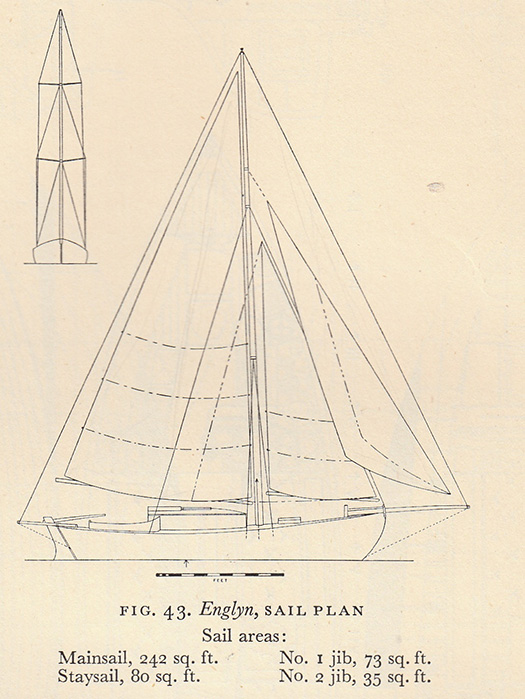
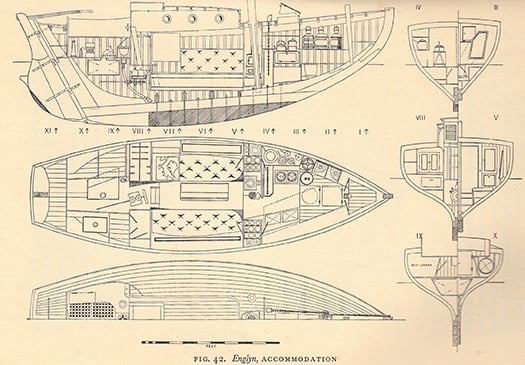
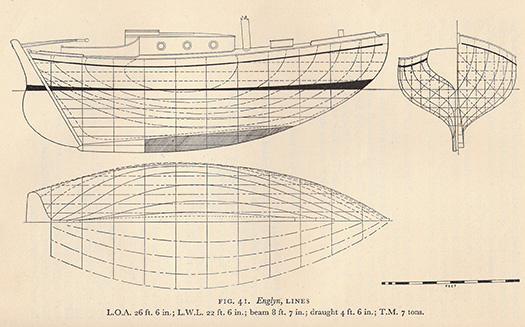
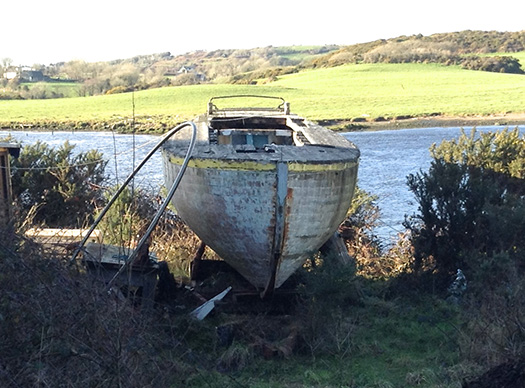
Englyn as she was last Monday at Oldcourt, as the re-birth of Ilen was being celebrated nearby. Photo: John Wolfe
World's Oldest Yacht Finally On Way For Conservation in Isle Of Man
#oldestyacht – What may well be the world's oldest yacht, the 1789-built 26ft schooner Peggy in the Isle of Man has finally been lifted out of her historic berth under Bridge House in Castletown in the isle of Man, and has been safely transferred to a specially-modified workshop in Douglas for the painstaking work of conservation to begin.
As the project with the historic Asgard by John Kearon and his team in Collins Barracks in Dublin revealed, conservation is a highly skilled job requiring much patience, and almost endless resources. But the wonderful Peggy, built 226 years ago for Manx renaissance man and pioneering yachtsman George Quayle, is very special indeed, and the people of the Isle of Man are determined to ensure that she gets the preservation treatment she deserves.
Video of the yacht being moved here
Read WM Nixon's full blog on Peggy here


























